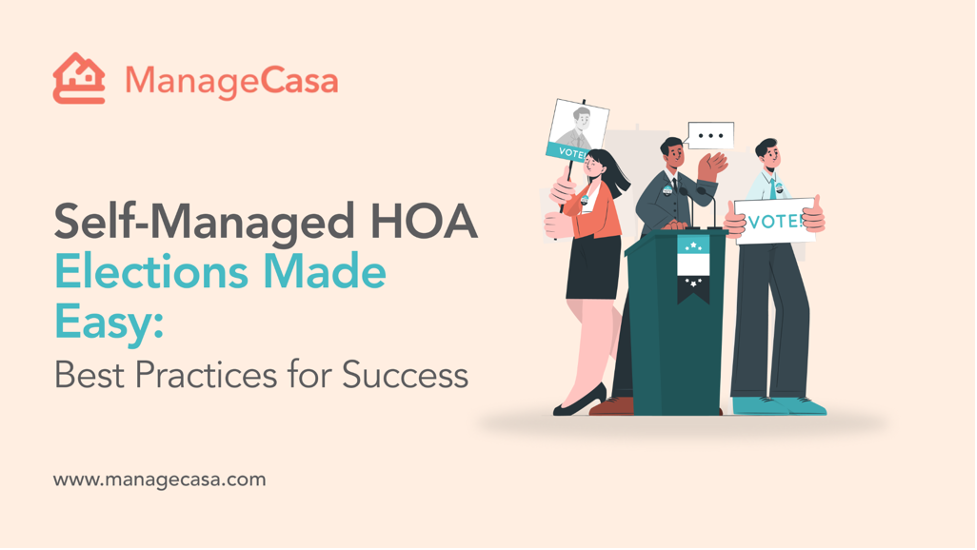Homeowners' associations (HOAs) play an essential role in maintaining community standards, resolving issues, and supporting positive neighborhood experiences. With more than 53% of U.S. households now part of an HOA, annual elections and the rules that govern them are more important than ever. critical than you may realize.
The HOA election process determines who sits on the board, how decisions are made, and how community resources are managed. However, challenges such as transparency, fairness, legal compliance, and proper documentation can complicate election procedures.
This guide provides clear, practical explanations of HOA election rules, voting regulations, and best practices so your community can run smooth, fair, and compliant elections every year.
Understanding HOA Election Basics
HOA elections give homeowners the power to choose board members who represent the community’s interests. Most governing documents—including CC&Rs and bylaws require annual or biennial elections to ensure ongoing representation.
Key concepts include:
Voting Rights
Most HOAs allow only homeowners (or designated representatives) to vote. This ensures accountability and prevents conflicts of interest.
Candidate Eligibility
Candidates must typically be homeowners in good standing and cannot use their board position for personal gain.
Governing Documents
Election rules are typically outlined in:
Understanding these documents is crucial for a lawful and transparent process.
Declarant Control and Transition of Power
In new developments, the declarant (developer) often maintains control of the HOA board until a set percentage of units are sold. This transitional period helps establish foundational rules and operations.
Typical transition triggers include:
-
Under 999 units: Declarant control ends 60 days after 25% of units are conveyed to homeowners.
-
Larger communities: Control shifts once 90% of units are sold or earlier if the developer voluntarily relinquishes authority.
Understanding these milestones ensures a smooth transition from developer-led governance to homeowner-led governance.
HOA Board Structure and Eligibility
A functional HOA board typically includes at least three officers:
-
President
-
Treasurer
-
Secretary
Common Eligibility Requirements
Candidates must:
-
Be homeowners or trustees/corporate representatives
-
Avoid conflicts of interest
-
Not benefit financially from board decisions
These requirements promote integrity, impartiality, and community confidence.
HOA Election Process: 5 Essential Stages

1. Setting the Foundation: Rules, Roles, and Requirements
A successful election begins with clarity on:
-
Quorum requirements: Commonly 10% of voting members
-
Nomination rules: Candidates may self-nominate or be nominated by others
-
Conflict disclosures: Candidates must declare financial or personal conflicts
These rules should be openly communicated to ensure transparency and fairness.
2. Preparing for Election: Planning and Communication
A clear election timeline prevents confusion and delays.
Key Preparatory Steps
-
Send annual meeting notices 30–45 days in advance
-
Mail or distribute ballots at least 15 days before voting
-
Provide candidate statements
-
Approve electronic voting if permitted by state law
Clear, well-documented communication strengthens community trust.
3. Ensuring Transparency and Security
Security measures protect voting integrity.
Best Practices
-
Secret ballots using multi-envelope systems
-
Proxy voting for members unable to attend
-
Ballots handled only by neutral parties or third parties
-
Public ballot counting to demonstrate transparency
This prevents manipulation and protects voter privacy.
4. Documenting and Validating the Election
Accurate recordkeeping protects the HOA from legal disputes.
Documents to keep for 10 years:
-
Ballots
-
Proxies
-
Attendance sheets
-
Meeting minutes
-
Counting procedures and results
Clear documentation supports transparency and legal compliance.
5. Addressing Disputes and the Post-Election Transition
Post-election tasks often include:
-
Certifying new board members
-
Reviewing governing documents
-
Training new members on state laws and procedures
-
Handling removal petitions (typically requiring 10% of member signatures)
A structured transition maintains continuity and prevents governance gaps.
Best Practices for HOA Elections: Ensuring Compliance, Transparency, and Community Engagement

Stay Compliant with State Laws
Election rules vary by state. HOAs should maintain an election compliance folder containing:
-
Timelines
-
Checklists
-
Statutory notice periods
-
Required disclosures
Use Electronic Voting to Increase Participation
When permitted, eVoting platforms:
-
Improve turnout
-
Reduce administrative workloads
-
Add security and audit trails
Maintain Thorough Records
All ballots, proxies, timelines, and meeting minutes must be archived for legal protection.
Why Maintain Strong HOA Election Rules?
A transparent election process:
-
Builds trust
-
Increases homeowner participation
-
Prevents disputes
-
Strengthens governance
-
Ensures board accountability
Annual policy reviews help HOAs remain compliant with evolving laws and community needs.
ManageCasa: A Modern Solution for Streamlined HOA Elections
ManageCasa simplifies and modernizes the HOA election process combining security, efficiency, and compliance into one seamless platform.
Key Features of ManageCasa’s HOA eVoting System
-
Secure & anonymous ballot submissions
-
Multiple notice formats & automated reminders
-
Support for paper ballots & mailing
-
Proxy voting compatibility
-
Voter list verification tools
-
Real-time results & detailed reporting
ManageCasa helps communities increase participation while reducing administrative burdens.
Ready to Modernize Your HOA Elections?
If you're looking to eliminate confusion, reduce manual tasks, and boost election turnout, ManageCasa can help.
Book a demo today and see how ManageCasa transforms HOA election management with secure, compliant eVoting tools.
Frequently Asked Questions



